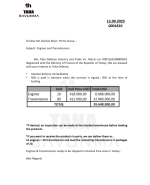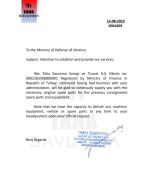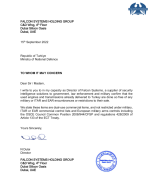From what I gather, Bayraktar's don't have any SATCOM capabilities. Is this the case with all the drones built by that company?
Turkish Military Technology : News & Discussion
- Thread starter RISING SUN
- Start date
You are using an out of date browser. It may not display this or other websites correctly.
You should upgrade or use an alternative browser.
You should upgrade or use an alternative browser.
The Turkish group Baykar showed a video of the test launch from the Bayraktar Akinci UAV of the Roketsan IHA-230 supersonic missile. The launch was made from the fourth prototype of the Akinci B UAV, equipped with Pratt & Whitney Canada PT6 series turboprop engines instead of the previously installed Ukrainian AI-450T engines. Supersonic air-to-ground missile IHA-230 - can operate day and night at a distance of up to 140 kilometers. The missile is an effective means against stationary ground and sea targets, radars and air defense systems.
The first torpedo drop by Turkey's MIR SIDE maritime drone. The Turkish military company ASELSAN, showed the first firing of torpedoes without a crewed military boat MIR SIDA. Details about a military boat that can be used as a marine drone are not reported. It is known that the MIR SIDA boat can be equipped with American Mk 44, Mk 46 and Mk 54 torpedoes. In the background, you can see that the boat is escorted by the Turkish MARLIN SIDA naval drone
Imagine getting ahead of USA and China in exporting your product , And that too in such short period of time . Big achievement indeed .
Turkish armored vehicle manufacturer Otokar showed off its new ALPAR unmanned armored vehicle. The prototype was demonstrated with the Otokar MIZRAK-30 combat module with a 30 mm cannon and the Roketsan OMTAS ATGM. The machine has a low thermal signature and can operate autonomously or be controlled remotely from a distance of up to 5 km. Otokar expects that the ALPAR robot will reduce the number of personnel performing tasks on the battlefield and reduce the risk to which they are exposed. The mass of the ALPAR robotic platform is 12 tons, the power plant is hybrid, diesel-electric with the possibility of full electric propulsion. The machine is controlled remotely by 2 people and it has a speed of up to 70 km/h, with a range of up to 500 km.
The first Azerbaijani-Turkish military exercises “Mustafa Kemal Ataturk-2023” took place in Karabakh and Nakhichevan. Up to 3 thousand personnel from various types of troops of the two countries took part in the tactical exercises, and 130 units of armored vehicles, up to 100 artillery pieces and more than 20 aviation and flight assets were also involved. In addition, engineering equipment was used. The main focus of the exercises was on the interaction of troops, improving command and control, exchanging experience and increasing the professionalism of personnel.
Looks like Turkish 'Taha Savunma' supplies Ukrainian MoD with engines and transmissions for Leo 1 through the network of intermediaries
Attachments
-
 PowerPoint Sunusu - Taha_Savunma_-_Transmissions_and_Engines_Prime_Group.png165.8 KB · Views: 136
PowerPoint Sunusu - Taha_Savunma_-_Transmissions_and_Engines_Prime_Group.png165.8 KB · Views: 136 -
 PowerPoint Sunusu - Taha_Savunma_-_Transmissions_and_Engines_Letter_Ukraine.png190.4 KB · Views: 131
PowerPoint Sunusu - Taha_Savunma_-_Transmissions_and_Engines_Letter_Ukraine.png190.4 KB · Views: 131 -
 Microsoft Word - Confirmation Statement 150922-1.docx - Turkieye_Confirmation_Statement_150922-1.png200.3 KB · Views: 138
Microsoft Word - Confirmation Statement 150922-1.docx - Turkieye_Confirmation_Statement_150922-1.png200.3 KB · Views: 138
Turkish jet UAV ANKA-3 made its first flight. The ANKA-3 heavy UAV was developed in 2022 by Turkish Aerospace Industries. The ANKA-3 UAV can perform many tasks, such as control and communication relay, reconnaissance, surveillance, and destruction of ground and air targets. The drone can hit enemy helicopters, propeller-driven aircraft and UAVs with air-to-air ammunition; to destroy ground targets, including radar and air defense systems, the drone has air-to-ground ammunition. The drone can also use large ammunition such as SOM-J, MK-82 and miniature SDB bombs. The ANKA-3 UAV can rise to a height of up to 12,000 meters, with a payload of up to 1,200 kilograms
Both Turkish and SK are developing their own MIC.
Meanwhile on the other hand we are destroying whatever indigenous capability we have.
Meanwhile on the other hand we are destroying whatever indigenous capability we have.
Refe @randomradio post in artillery section. You will get to know who really is your enemy.Both Turkish and SK are developing their own MIC.
Meanwhile on the other hand we are destroying whatever indigenous capability we have.
Azerbaijan showed off its Turkish-made Bayraktar Akıncı UAVs. Azerbaijan presented the Bayraktar Akıncı UAV received from Turkey. The Bayraktar Akinci UAV was developed by Baykar and made its first flight in 2019; we previously reviewed it. The Bayraktar Akinci UAV is equipped with a variety of missiles and ammunition, examples of which you can see in the photo. On board there is an Aselsan optical-electronic station and a radar with an active phased array antenna. The UAV is equipped with 2 Ukrainian AI-450T turboprop engines with a power of 450 hp each. s., or two Turkish piston engines PD-222. The maximum speed of the UAV is up to 360 km/h, flight range up to 7500 km, at an altitude of up to 13700 meters, flight duration up to 24 hours. Akıncı UAV uses satellite communications.
US Turns to Turkey for Explosives as War in Ukraine Saps Supply
The US is in talks to ramp up purchases of explosives from Turkey to boost production of artillery shells as allies scramble to ship badly needed ammunition to Ukraine.Turkish supplies of trinitrotoluene, known as TNT, and nitroguanidine, which is used as a propellant, would be crucial in the production of NATO-standard 155mm caliber ammunition — potentially tripling production, according to officials familiar with the discussions. Turkey is already on track to becoming the biggest seller of the artillery shells to the US as early as this year.
Russia’s two-year war in Ukraine has triggered a surge in global demand for ammunition, with Western allies pushing to supply Kyiv even as they replenish their own depleted stocks. The demand spike has led to a backlog in global orders and put a strain on defense supply chains, particularly on components such as TNT, the officials said on condition of anonymity.
The dealmaking with Ankara also lays bare a delicate balance between the North Atlantic Treaty Organization allies, whose relations have been strained by Russia’s invasion and Turkey’s months-long blockade of Sweden’s accession to the military alliance.
President Recep Tayyip Erdogan plans to visit the White House on May 9 for the first time since President Joe Biden took office as the two smooth over military ties. Turkey’s approval of Sweden’s NATO membership this year cleared the way for Washington to sign off on a $23 billion sale of American-made F-16 warplanes, missiles and bombs to Ankara.

The partnership on ammunition production would build on that. The Pentagon in late February said it contracted General Dynamics Ordnance and Tactical Systems to build three 155mm projectile metal parts lines in Texas, including with Turkish subcontractors. The plant in Mesquite, Texas, is scheduled to move into production in June, the company said.
Catching Up With Moscow
Production lines of Turkish defense firm Repkon are expected to produce some 30% of all US-made 155mm artillery shells by 2025, the people said. In addition, the Defense Department purchased 116,000 rounds of battle-ready ammunition from Turkey’s Arca Defense for delivery this year, with further purchases expected soon for delivery next year, the people added.In a statement on the Texas investment and Turkish industry, the Pentagon said working with allies “is key to building a global defense industrial base.” Turkey’s Defense Ministry and defense-procurement agency didn’t immediately respond to a request for comment.
The US and European efforts are part of a race to catch up with Moscow, whose war machine has put it in a position to produce or procure — according to some estimates — 4 million rounds this year, including shipments from North Korea. By contrast, the European Union expects to triple its production of artillery shells this year to around 1.4 million units.
As big defense companies and smaller suppliers start to ramp up production, US and European ammunition output is expected to significantly increase next year and the year after, Western officials say.
The Turkish army tested a long-range missile for the Hisar-O air defense system. The Turkish Hisar-O medium-range air defense system is expected to become the basis of Turkey's Steel Dome air defense system. The missile reportedly successfully hit a target at a distance of more than 40 kilometers. The Hisar-O air defense system was first unveiled by the Turkish company Aselsan in 2015. The Hisar-O air defense system is capable of detecting and tracking a fighter-type target at a distance of up to 60 km. On August 15, the Turkiye newspaper reported that Turkey intends to use Russian S-400 air defense systems until its own air defense system is created.

Türkiye tests cruise missile Kara Atmaca in longest trial yet
Türkiye's latest defense innovation, the Kara Atmaca long-range surface-to-surface cruise missile, has undergone its longest-range and...
Future Pakistani missile
turbojet powered, not sure of turbofan variant yet
Türkiye tests cruise missile Kara Atmaca in longest trial yet
Türkiye's latest defense innovation, the Kara Atmaca long-range surface-to-surface cruise missile, has undergone its longest-range and...www.dailysabah.com
Future Pakistani missile


